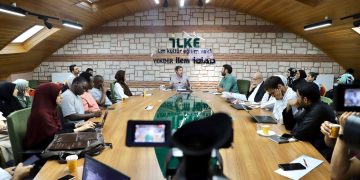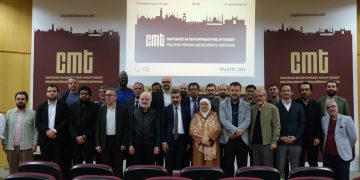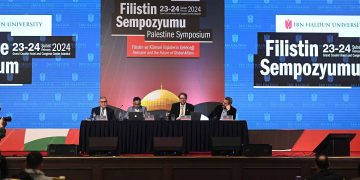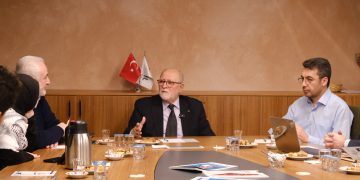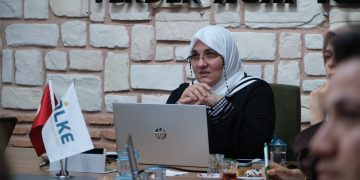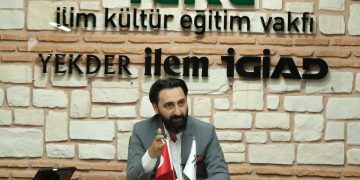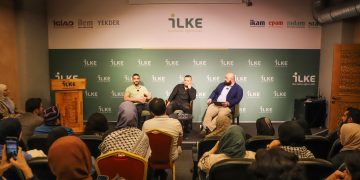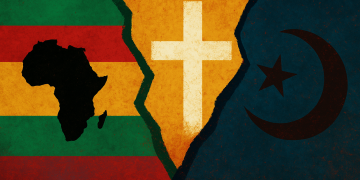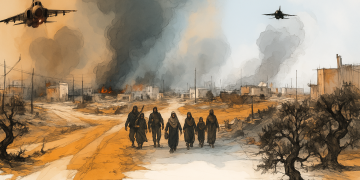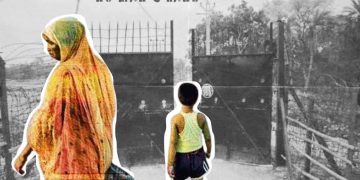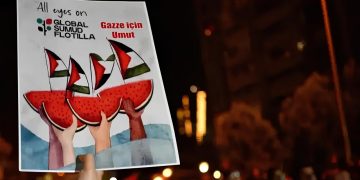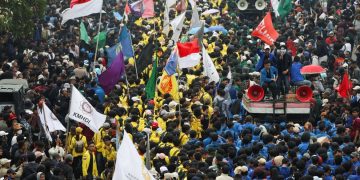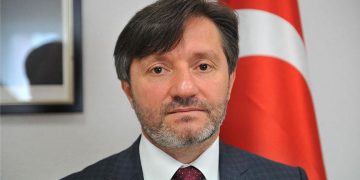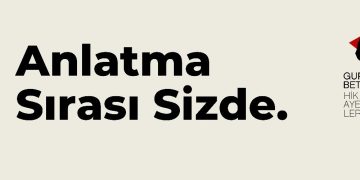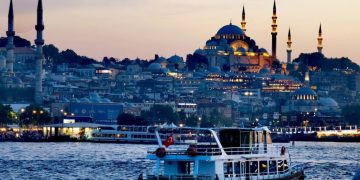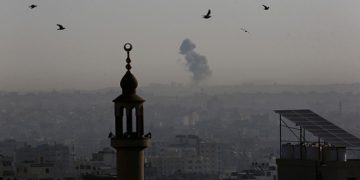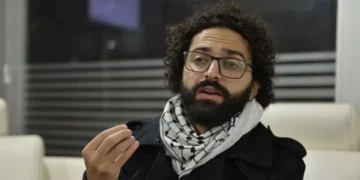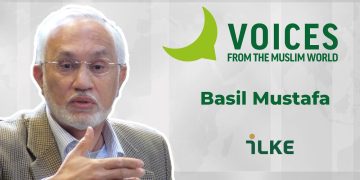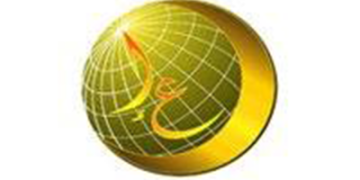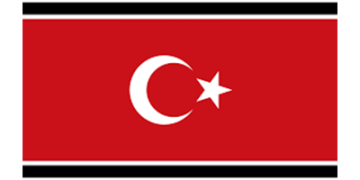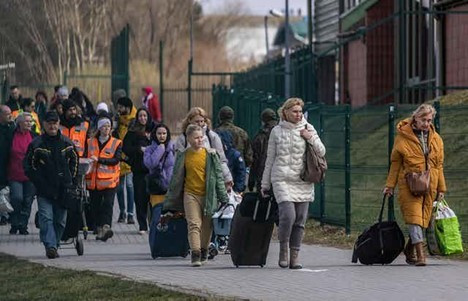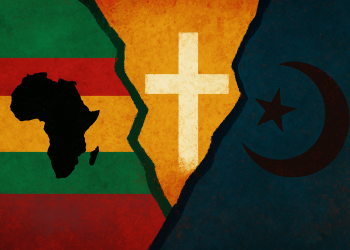In the period since Russian tanks entered Ukraine on February 24, 2022, the Russian-Ukrainian War has been handled by various Muslim NGOs, research centres and similar institutions. In particular, North African countries such as Egypt and Morocco and countries in the Middle East have carried out studies examining the economic, military and humanitarian dimensions of war. In this article, the military, human rights and migration effects of the Ukraine-Russia War will be examined in the Intellectual Backgrounds Bulletin of the Muslim World. Then the repercussions of the war on the states of the region will be evaluated.
Military Dimension of War
Although the Russia-Ukraine War initially began as if it were a conventional war, it was later understood that it would be a combination of types such as armed group warfare, guerrilla warfare, proxy war. One of the most notable military features of the war is that the Ukrainian authorities announced that they had accepted volunteers to fight against the Russians in the early days of the war. (President of Ukraine, 2022) Moscow then announced that non-Russian fighters had been accepted and organized to fight alongside its forces in Ukraine. (Allam, 2022) This situation brings back the phenomenon of foreign fighters that we have already witnessed in Syria or Iraq.
The majority of foreign troops in Ukraine are Ukrainians living abroad with dual citizenship. These volunteers, who are of Ukrainian descent and live in other countries, quit their jobs after Zelenski’s call and came to “fight in the land where their grandfathers fought before”. Ukrainian Defense Minister Oleksii Reznikoz said the number of volunteer fighters arriving in this way was more than 66,000. (Harding, 2022) Among the foreign fighters who have gone to Ukraine, the number of people who have no connection to Ukraine also seems to be quite high. Zelenski said in a statement that the number was higher than 16,000. Most of the volunteers come from NATO countries, but there are also 25 other countries such as Japan, Jamaica, and Colombia. There are reports that most of the incoming soldiers are retired soldiers and even the soldiers who escaped from their battalions in England were among them. (Marshall, 2022) Among the fighters who voluntarily went to Ukraine, the number of fighters from countries that were previously affiliated with the Soviet Union is also quite high. Those who leave these countries are also going to pursue their internal reckonings against Russia. It is available to soldiers from existing Russian republics such as Chechnya. Russia, on the other hand, has approved the deployment of 16,000 foreign fighters from the Middle East. However, US officials have made a statement that they have yet to see any evidence of such an event. Syria-based news organizations, on the other hand, stated that the commanders of at least one Russian-backed paramilitary force agreed to send soldiers. (Seldin, 2022) Some sources state that the use of these soldiers, who are experienced in fighting in the city, by Moscow is logical as it will reduce official soldier losses. (Lubold, Youssef, and Cullison, 2022) As for Chechen President Ramzan Kadyrov, he announced that he fully supported President Putin at a military parade with approximately 10,000 fighters on February 25 and that he would join the war alongside the Russian forces in Ukraine. (Mchedlishvili, 2022) Contrary to Kadyrov’s statement, there are also two Chechen Battalions Fighting in Donbas since 2014. Chechen soldiers are fighting on both sides of the firing line.
The influx of foreign fighters has advantages as well as disadvantages. First of all, fighters from different conflict zones are burdened with the complexities of the conflict in the regions they come from, which further complicates the current conflict environment. Also, civilians who have little awareness of the war situation travel to fight, although experienced fighters come voluntarily. It is also possible that the logistics lines established to transport and recruit volunteer fighters are used by malicious actors to send extremist, violent individuals to the battlefield. In addition, the multiplicity of foreign actors is a factor that increases the duration and severity of the conflict. While the conflict is a local one, its size can be changed by imposing transnational factors. In addition, Terrorist Expert Daniel Byman stated that idealistic foreigners in the conflict zone are radicalized and terrorized much more easily. (Fink and Clarke, 2022) It is also unclear whether these groups will be able to go back to their countries later on, or they will have great difficulties in adapting even if they do.
Human Rights and Migration
Some institutions, on the other hand, dealt with the human rights violations of the war and migration issues. The Cairo Institute for Human Rights Studies (CIHRS) has published an article condemning Russia’s military invasion of Ukraine in violation of international law. The CIHRS stated that Russia has a direct role in ensuring that the Assad dictatorship remains in power by using brutal military force against its civilian population. He added that authoritarian powers in the Middle East, such as Saudi Arabia and the UAE, do not tolerate any democratic progress as Russia does. CIHRS and other human rights organizations in the region have warned that if it fails to uphold people’s legitimate aspirations for justice and dignity, global authoritarianism will strengthen and eventually endanger even established democracies in Western Europe and North America. Failure to protect international law in the face of violations such as the US invasion of Iraq or Israel’s annexation of the Golan Heights and East Jerusalem and annexation of the West Bank is one of the reasons for the current situation. In the face of the ongoing violations in Yemen, Egypt, and Palestine and the grave violations in Syria, where Russia bears great responsibility, the passivity of the international community has come to a point where the sovereign states are in danger. (The Cairo Institute for Human Rights Studies, 2022)
The heavy destruction of the humanitarian aspect by the Russian attacks continues in Ukraine. The UN Human Rights Council has issued a resolution stating that it is deeply concerned about the documented harm to the enjoyment of many human rights, such as life, education, and health, from Russia’s bombing of populated areas. (The Cairo Institute for Human Rights Studies, 2022) The United Nations High Commissioner for Refugees (UNCHR) said that as a result of gross and systematic violations of human rights, more than 1.2 million people in the region had to take shelter in neighboring countries, and 1 million people had to move within the country. has reported. He also warned that this number could rise to over 4 million in the coming weeks. (The Un Refugee Agency, 2022)
Europe’s response to this refugee crisis at the door is quite different from its response to the Syrian refugee crisis. After the migrant crisis in 2015 brought harsh reactions and inconclusive crises in the European Union, it is seen that the Ukrainian migration crisis emerged with limited concern in European countries. For the first time, the European Union implemented the provisions of the 2001 Temporary Protection Directive, providing unlimited admission of refugees during a crisis, and instant and automatic acceptance of refugee status, without requiring an asylum application. Poland, which is strongly against opening the doors to non-EU refugees, has interestingly stated that it is always open to accepting Ukrainian asylum seekers (Martin, 2022).
Although the reasons for this ironic situation will change as a result of the length and course of the war, for now, it can be explained as follows: Firstly, the war in Ukraine and solidarity with Ukrainian refugees are seen as a part of the stance against Russia for Europeans. Wars in Syria, Afghanistan, Libya, or Ethiopia do not mobilize European public opinion in the same way as a war on European soil. In addition, the presence of migrant workers, who started to arrive in European countries in the 90s and form a large diaspora, is effective in this regard. The Ukrainian diaspora quickly took action to welcome their relatives. Third, cultural and ethnic similarity is an important factors. Finally, it is more difficult to prevent Ukrainian refugees than Syrian or Afghan refugees because Ukraine has a direct border of about 1,400 km with European countries (Fink and Clarke, 2022).
As Europe faces an unprecedented migration crisis, it appears to be calmly preparing to accommodate these new refugees in the best of humane conditions and ultimately integrate them into European societies and labour markets. This shows that the crisis experienced in 2015 was a crisis of acceptance and rejection of non-European immigrants. Also, third-country nationals, such as the tens of thousands of African students in Ukraine, are not welcomed in the same way. These people are either given temporary visas until they go to their country’s borders, or they are prevented from even getting on the trains. The African Union (AU) made a “shocking and racist” statement on this issue (African Union, 2022).
Regional Effects of War
The regional effects of the Russia-Ukraine Crisis have been discussed in detail by institutions in Muslim countries, but studies have focused on a few specific regions. In this section, we will proceed through the regions where the studies are concentrated.
Iran
How the Ukraine-Russia Crisis affects Russia-Iran relations is the subject of the analysis published by many non-governmental organizations in the Muslim World. Looking at the process so far, negative effects have been seen in relations with Iran as a result of the pressure Russia tried to establish on Western countries by using its role in the nuclear agreement in the first stage of the crisis (Vienna negotiations). However, Tehran’s desire to keep its relations with Moscow strong enabled the temporary tension between the two countries to be brought under control. Iran and Russia have been willing to establish strong relations between them in light of the remarkable convergence on many issues. The most important axes of rapprochement between the two countries are to protect the stability of the Caucasus region and to support the Syrian regime, as well as not allow the forces from outside the region to dominate the Central Asian and Caspian Sea countries. The sanctions imposed on Iran have led Iran to strengthen relations with Russia and China. (AlSami, 2021)
Cooperation between Russia and Iran has grown remarkably in recent years as they faced harsh US sanctions imposed on them years ago and therefore continually strengthened their economic, military, and security relations. On the economic side; The two countries cooperate in fields such as energy, infrastructure (railways), and aviation. Iran and Russia also share the growing concern about Turkey’s intervention in the Caucasus region following Azerbaijan’s military victory over Armenia in the conflict in the Nagorno-Karabakh region (Saber, 2022).
Regarding the Russia-Ukraine crisis, Iran stands by Moscow, with which it has “fought together against the United States for 40 years”. The Supreme Leader of Iran, Ali Khamenei, stated in a speech that “Ukraine, which is facing Russian occupation, is a victim of the policies of the United States”. The economic dimension of the crisis can be an opportunity for Iran. Since oil and gas prices have risen to a level that they have not reached for years, entering the global energy market immediately will provide significant financial returns for Iran (Saber, 2022).
Syria
When examining the regional repercussions of the Ukraine-Russia war, one of the first regions that come to mind is Syria, where Russia is a key actor. The Assad regime made it clear in the early days of the war that it would be on the side of Russia. The Russian occupation of Ukraine led to a “relative decline” in Moscow’s interest in the Syrian crisis, especially at the military level. There is a noticeable decrease in the activities of Russian forces in many parts of Syria. Russian-American interaction in Ukraine and its reflections in the Syria file, Russia’s invasion of Ukraine and Turkey’s volatile interaction are related.
One of the most serious factors that will affect Syria as a result of Russia’s invasion of Ukraine is the negative economic effects. The dependence of Damascus on foodstuffs, oil and gas imports from Ukraine and Russia will increase the weight of the sanctions imposed by the USA on itself, as well as the sanctions against Russia, which has begun to affect natural gas and oil. In addition, these developments are expected to affect the value of the Syrian lira, and the decrease in purchasing power is expected to increase the daily burden on the lives of Syrians (Ahmed, 2022).
Africa
The New South Policy Center has published an analysis of the effects of the Russia-Ukraine Crisis on Africa. This war will have far-reaching effects on the African continent in terms of energy, food security, and democratic governance. Russia’s influence on Africa has been expanding steadily over the past two decades. Moscow has gained advantages in African capitals, in part through arms sales. Meanwhile, Ukraine is one of the top 10 arms exporters in the world, and a significant percentage of Ukrainian arms go to Africa. SPIRI published a report that between 2005 and 2009 20% of Ukraine’s arms exports went to African countries (Holtom, 2011)
In addition, another report revealed that African states have not implemented any sanctions against Russia since 2014. On the other hand, most of the continental countries have taken an impartial stance on the UN’s decisions on Ukraine (Barabanov, 2022). Some African countries calculate that the conflict at the heart of Europe and the ensuing geopolitical realignments can provide economic opportunities for the continent, particularly in Europe. European states are moving away from Russian natural gas and oil. Tanzanian President Samia Suluhu Hassan, who wants to invest 30 billion dollars to benefit from the newly discovered oil in the Indian Ocean, said, “Whether it is Africa, Europe or America; We are looking for a market.” used the expressions (Norbrook, 2022).
The invasion of Ukraine could affect food security and put economic pressure on African households by triggering a spike in oil prices. The Black Sea region is home to large fertile agricultural lands. War in the “breadbasket of the world” could threaten wheat and fertilizer supplies. When the Soviet Union collapsed, Russia and Ukraine were net importers of grain; today, two countries realize 29% of world wheat export. The recent rise in wheat prices may endanger food security in Africa and Asia, especially in countries such as Bangladesh, Pakistan, and Sudan, which receive 50 percent or more of their wheat from Russia or Ukraine in 2020 (Yee and Alami, 2022).
Ukraine’s restriction on wheat exports in 2010 led to an increase in food prices in the MENA region, and this situation, which also led to protests, resulted in the Arab Spring. Russia and Belarus are also important exporters of fertilizers, and the recent rise in prices is threatening global crop production. As Michael Puma and Megan Konar have recently written, the sanctions regime imposed on Russia must be carefully adjusted so as not to increase food shortages in low-income countries (Puma and Konar, 2022). Increasing economic hardship and social discontent does not bode well for democratic rule in Africa, especially in light of recent military coups. In the last 18 months, military leaders have taken power in Burkina Faso, Chad, Guinea, Mali, and Sudan. The democratic recession may be exacerbated by the economic repercussions of the Russo-Ukrainian war and by Russia’s aggressive anti-liberal diplomacy (Aidi, 2022).
The crisis in Ukraine came at a critical moment for the global economy. In particular, supply line cuts and sanctions could exacerbate the rise in inflation by affecting Russian trade, which is the largest exporter of many commodities, including energy, grain, fertilizer, and minerals. The Middle East and North African regions are vulnerable to rising commodity prices as they are major importers of foodstuffs, particularly wheat, and are particularly dependent on exports from Russia and Ukraine. In addition, many MENA countries are experiencing currency shortages and may soon have to devalue their currencies; while this may increase domestic inflation, while some other MENA countries such as Tunisia and Lebanon may face debt crisis risks (Al-Ahram Center for Political and Strategic Studies, 2022). These pressures can jeopardize food security and increase poverty and social unrest in the region. On the other hand, gas and oil-exporting countries in the region will benefit from the increase in energy prices and the increased demand for energy resources in the region.
References
العقوبات االقتصادية عىل 16). March (2022, H. Suleiman, https://acpss.ahram.org. .روسيا ومخاطر التصعيد املتبادل eg/News/17434.aspx
Russian Government. (2022, March 7). The government approved the list of countries and territories unfriendly to Russia (Order dated March 5, 2022 No. 430-r). Russia Government. http://government.ru/docs/44745/
- (t.y). G7 rejects Russia’s demand for gas payment in rubles. https://www.dw.com/en/g7rejects-russias-demand-for-gas-payment-inrubles/a-61282564
Fulwood, M., Hanore, A., Sharples, J., Hall, M. (2022, March). The EU plan to reduce Russian gas imports by two-thirds by the end of 2022: Practical realities and implications. The Oxford Institute For Energy Studies. https:// www.oxfordenergy.org/wpcms/wp-content/ uploads/2022/03/Insight-110-The-EU-planto-reduce-Russian-gas-imports-by-twothirds-by-the-end-of-2022.pdf
International Energy Agency. (2022, March 3). A 10-Point Plan to Reduce the European Union’s Reliance on Russian Natural Gas.https:// iea.blob.core.windows.net/assets/1af70a5f9059-47b4-a2dd-1b479918f3cb/A10-PointPlantoReducetheEuropeanUnionsRelianceonRussianNaturalGas.pdf
Canuto, O. (2022, March). War in Ukraine and Risks of Stagflation. Policy Center For the New South. https://www.policycenter.ma/sites/default/files/2022-03/PB_18-22_Canuto_0.pdf
President Of Ukraine. (2022, February 27). Appeal to foreign citizens to help Ukraine in fighting against Russia’s aggression. https:// www.president.gov.ua/en/news/zvernennya-do-gromadyan-inozemnih-derzhav-yaki-pragnut-dopom-73213
املقاتلون األجانب: هل علينا 15). March (2022, S. R. Allam,
https://acpss.ah.االستعداد لظاهرة “العائدين من أوكرانيا”؟ ram.org.eg/News/17432.aspx#
Harding, L. (2022, March 11). This article is more than 1 month old ‘My plan is there is no plan’: the foreign fighters flocking to Ukraine. https://www.theguardian.com/world/2022/ mar/11/ukraine-russia-war-foreign-fighters-volunteers
Marshall, A. (2022, March 8). For foreign fighters, Ukraine offers purpose, camaraderie and a cause. https://www.reuters.com/world/ europe/foreign-fighters-ukraine-offers-purpose-camaraderie-cause-2022-03-07/
Seldin, J. (2022, March 11). US Sees No Evidence of Syrian, African Mercenaries in Ukraine. https://www.voanews.com/a/us-sees-no-evid ence o f-s yr i anafr ica n-me rce naries-in-ukraine/6481309.html
Lubold, G., Youssef, N.A., Cullison, A. (2022, March 6). Russia Recruiting Syrians for Urban Combat in Ukraine, U.S. Officials Say. https://www. wsj.com/articles/russia-recruiting-syriansfor-urban-combat-in-ukraine-u-s-officialssay-11646606234
Mchedlishvili, L. (2022, March 8). ‘We have only one enemy — this is Russia’: the Chechens taking up arms for Ukraine. https://oc-media.org/features/we-have-only-one-enemy-this-is-russiathe-chechens-taking-up-arms-for-ukraine/
Fink, N. C., Clarke, C. P. (2022, March 10). Foreign Fighters Are Heading to Ukraine. That’s A Moment for Worry. https://www.politico.com/ news/magazine/2022/03/10/foreign-fighters-are-heading-to-ukraine-thats-a-momentfor-worry-00016084
The Cairo Institute for Human Rights Studies (CIHRS). (2022, February 24). The Cairo Institute for Human Rights Studies Condemns Russia’s Invasion of Ukraine. https://cihrs.org/thecairo-institute-for-human-rights-studies-condemns-russias-invasion-of-ukraine/?lang=en
The Cairo Institute for Human Rights Studies (CIHRS). (2022, March 8). Russian Federation: UN General Assembly should suspend Russia’s rights of membership of the UN Human Rights Council. https://cihrs.org/russian-federationun-general-assembly-should-suspend-russias-rights-of-membership-of-the-un-humanrights-council/?lang=en
The Un Refugee Agency (UNHCR). (2022, March 3). News Comment: 1 million refugees have fled Ukraine in a week. https://www.unhcr.org/news/ press/2022/3/62206a824/news-comment-1-million-refugees-fled-ukraine-week.html
Martin, I. (2022, March 11). The War in Ukraine: A Migration Crisis Like No Other. https:// w w w.polic ycenter.ma/publications/ war-ukraine-migration-crisis-no-other
African Union. (2022, February 28). Statement of the African Union on the reported ill treatment of Africans trying to leave Ukraine. https:// au.int/en/pressreleases/20220228/statementill-treatment-africans-trying-leave-ukraine
روسيا والصني «أولوية» رئييس يف 20). August (2021, A. Al-Sami, https://bit.ly/3ucWQNB .السياسة الخارجية اإليرانية
هل تؤثر األزمة األوكرانية عىل 28). March (2022, S. Saber,
https://acpss.ahram.org. .العالقات الروسيةاإليرانية؟ eg/News/17452.aspx
األزمة السورية والحرب ىف 9). March (2022, M. S. Ahmed, https://acpss.ahram.org. .أوكرانيا .. االنعكاسات واملآالت eg/News/17426.aspx
Holtom, P. (2011, February). Ukraini an Arms Supplies to Sub-Saharan Af rica. https://www.sipri.org/publications/2011/ sipri-background-papers/ ukrainian-arms-supplies-sub-saharan-africa
Barabanov, I. (2022, February 27). Ukraine conflict: How Russia forged closer ties with Africa. https://www.bbc.com/news/ world-africa-60506765
Norbrook, N. (2022, February 22). Tanzania: President Samia says Russia/Ukraine tension an opportunity for gas sales. https://www.theafricareport.com/178985/tanzania-presidentsamia-says-russia-ukraine-tension-an-opportunity-for-gas-sales/
Yee, V., Alami, A. (2022, February 25). In North Africa, Ukraine War Strains Economies Weakened by Pandemic. https://www.nytimes. com/2022/02/25/world/middleeast/innorth-africa-ukraine-war-strains-economiesweakened-by-pandemic.html
Puma, M. J., Konar, M. (2022, March 1). What the war in Ukraine means for the food supply. https://www.nytimes.com/2022/03/01/opinion/what-the-war-in-ukraine-means-for-theworlds-food-supply.html
Aidi, H. (2022, March 22). The Russia-Ukraine War: Implications for Africa. https:// w w w.polic ycenter.ma/publications/ russia-ukraine-war-implications-africa
StudStrategic and Political for Center Al-Ahram ندوة افرتاضية حول التداعيات اإلنسانية 21). March (2022, ies. https://acpss. .لألزمة يف أوكرانيا عىل الرشق األوسط وشامل إفريقيا ahram.org.eg/News/17437.aspx#

